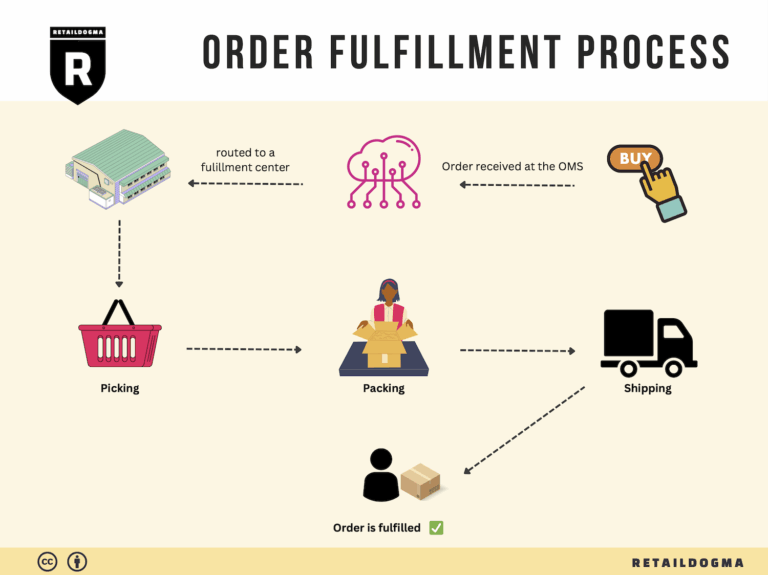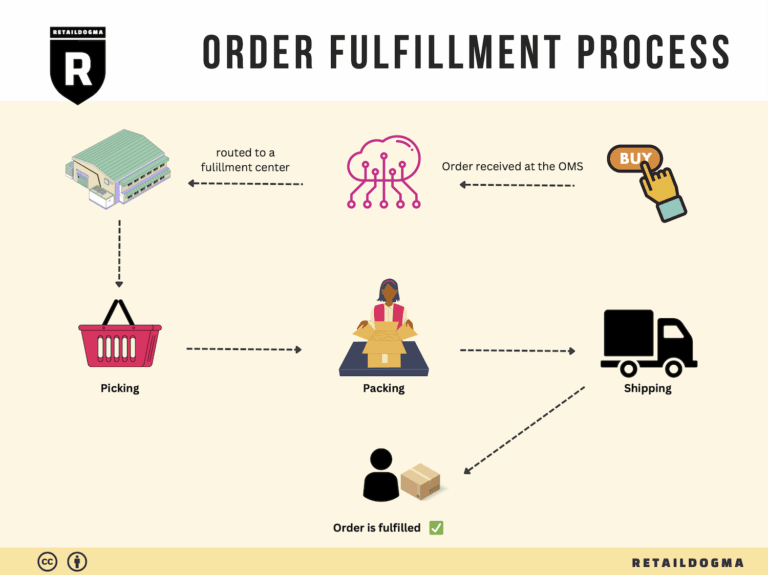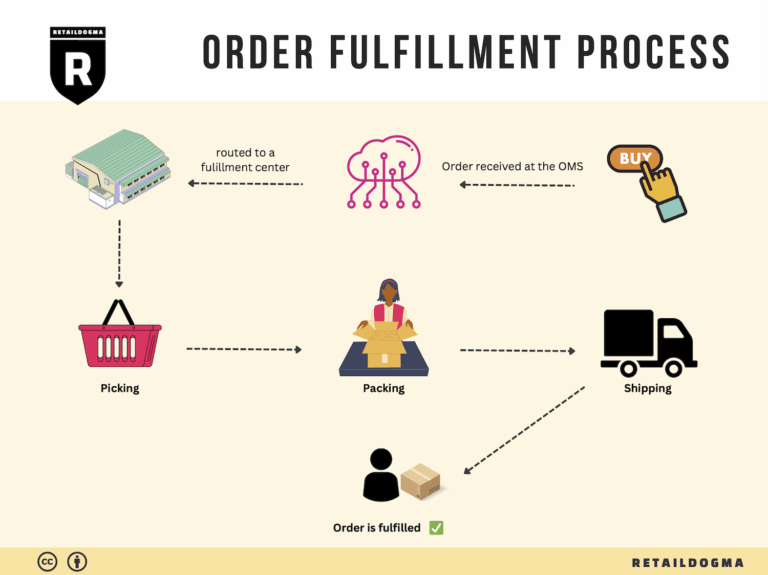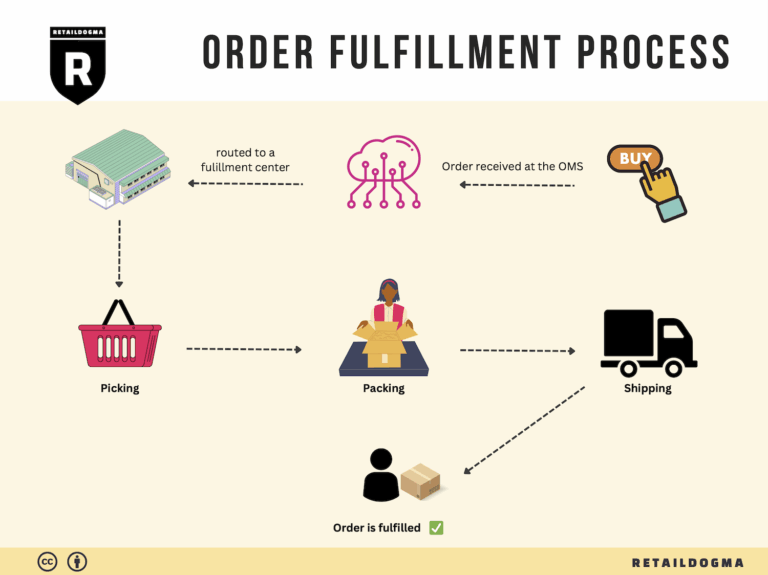What Is A Fulfillment Center? A Complete Guide (2025)
What is E-commerce Fulfillment? An Introduction for Growing Businesses
Understanding the Challenges of Order Fulfillment
As an e-commerce business owner, you’ve likely experienced the growing pains of managing packing and shipping orders. The excitement of making sales can quickly turn into a daunting challenge when faced with the logistics of getting products to your customers efficiently. For many growing online businesses, the fulfillment process becomes overwhelming, often leading to delays, errors, and ultimately, dissatisfied customers.
Defining E-commerce Fulfillment
In simple terms, e-commerce fulfillment is the process of getting a product to a customer after an order is placed. This encompasses everything from inventory management and order processing to packing and shipping. It’s a vital component of your business that directly affects customer satisfaction and your bottom line. The fulfillment process is not just a logistical necessity; it’s a critical touchpoint that can enhance your brand reputation or lead to customer churn if mishandled.
What This Guide Covers
This comprehensive guide aims to demystify e-commerce fulfillment for growing businesses. We will explore various fulfillment models, including Third-Party Logistics (3PL) and Fulfilled by Amazon (FBA), helping you understand the pros and cons of each. You’ll learn about core fulfillment services such as inventory management, order processing, packing, shipping, and returns handling.
Additionally, we will provide insights on how to choose the right fulfillment partner that aligns with your business goals. We will also touch on the pricing structures associated with different fulfillment options, enabling you to make informed decisions that fit your budget and operational needs.
Empowering Smart Decisions
The ultimate goal of this guide is to empower you, the business owner, with the knowledge needed to navigate the complexities of logistics and fulfillment. By understanding the various components of the fulfillment process and knowing how to select the right partners, you can streamline operations, enhance customer satisfaction, and scale your e-commerce business effectively. With the right strategies in place, fulfillment doesn’t have to be a pain point—it can be a powerful driver of growth.
What You’ll Learn In This Guide
- What is E-commerce Fulfillment? An Introduction for Growing Businesses
- The Order Fulfillment Process: From ‘Buy’ Button to Customer’s Door
- Comparing Fulfillment Models: In-House vs. 3PL vs. Dropshipping
- A Deep Dive into Amazon FBA: Pros, Cons, and Who It’s For
- Core Services Offered by Fulfillment Centers
- How to Choose a Fulfillment Partner: A 6-Point Checklist
- Understanding Fulfillment Pricing: A Breakdown of Common Fees
- Frequently Asked Questions (FAQs) about Fulfillment
- Conclusion: Is Outsourcing Fulfillment the Right Move for Your Business?
- Important Disclaimer
The Order Fulfillment Process: From ‘Buy’ Button to Customer’s Door
1. Receiving Inventory
The order fulfillment process begins with receiving inventory, a crucial step that lays the foundation for the entire operation. This stage involves the arrival of goods from suppliers or manufacturers into the fulfillment center. Upon receipt, inventory must be counted, inspected, and recorded to ensure that the correct quantities and quality of products are received. This is where Stock Keeping Units (SKUs) come into play. SKUs are unique identifiers assigned to each product, enabling efficient tracking and management throughout the inventory lifecycle.
Why is this step important? Accurate receiving is vital to prevent stock discrepancies, which can lead to order fulfillment errors and customer dissatisfaction. If the wrong quantity or damaged goods are received, it can disrupt the entire supply chain. Ensuring that inventory is correctly received and logged helps maintain a reliable stock level and enhances operational efficiency.
2. Warehouse Storage
Once inventory is received, the next step is warehouse storage. During this phase, items are organized and stored in designated areas within the fulfillment center. Efficient storage strategies are essential for optimizing space and facilitating quick access to products when orders are placed. Items may be stored in various configurations, such as bulk storage, shelving, or bins, based on their size and demand frequency.
The significance of this step lies in its impact on order processing speed. Properly organized storage reduces the time needed to locate and retrieve products, which is crucial for maintaining a competitive edge in e-commerce. Additionally, understanding storage principles, such as FIFO (First In, First Out), can help manage perishable goods and ensure that older stock is sold first, minimizing waste and maximizing profitability.
3. Order Picking
Order picking is the stage where items are selected from storage to fulfill customer orders. This process can be manual or automated, depending on the scale of operations. A pick list, which details the items and their locations within the warehouse, is generated for each order. This list serves as a guide for the picking team or automated systems to ensure accuracy.
The importance of order picking cannot be overstated; it directly affects the accuracy and speed of order fulfillment. Errors during this stage can lead to incorrect shipments, resulting in returns and customer dissatisfaction. Implementing efficient picking methods, such as batch picking or zone picking, can help streamline operations and reduce fulfillment times, ultimately enhancing the customer experience.
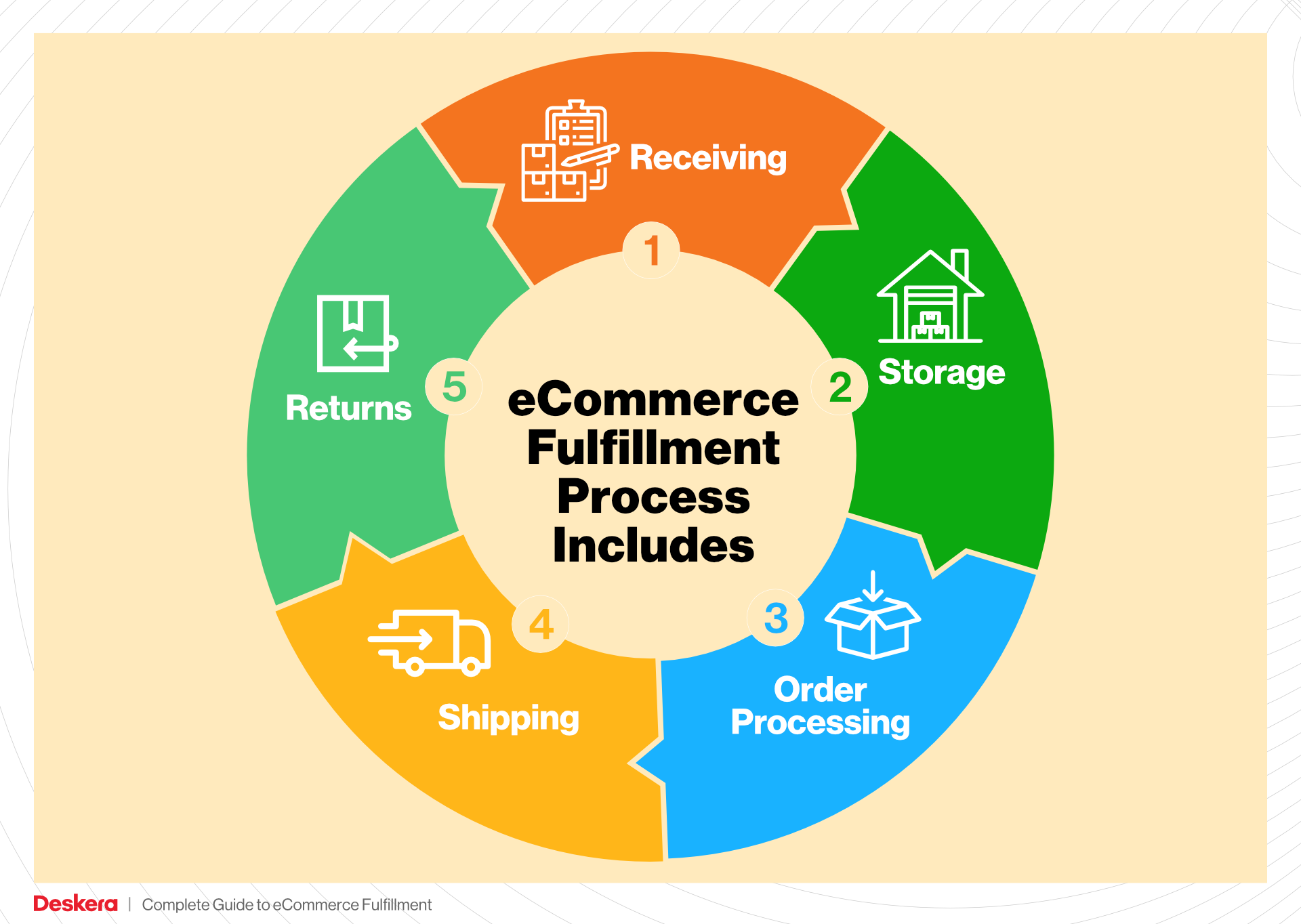
4. Order Packing
After picking, the next step is order packing. This involves carefully packaging the selected items to ensure they arrive at the customer’s location in good condition. During packing, teams often use packing slips, which accompany the shipment and provide essential information, such as item descriptions and quantities. Additionally, optimizing the dimensional weight (DIM weight) of packages is crucial for reducing shipping costs.
Packing is critical because it protects the products during transit and helps create a positive unboxing experience for customers. Including return shipping materials and labels can also facilitate future exchanges or returns, enhancing customer satisfaction. Well-executed packing processes can significantly reduce the likelihood of damaged goods, which can be costly for businesses in terms of both replacements and customer trust.
5. Shipping & Delivery
The final step in the order fulfillment process is shipping and delivery. Once packed, orders are handed off to shipping carriers, which may include services like FedEx, UPS, or USPS. It’s essential to choose the right carrier based on factors such as delivery speed, cost, and reliability. Understanding the concept of last-mile delivery is particularly important, as this refers to the final leg of the shipping journey, where the package is delivered from a distribution center to the customer’s doorstep.
This step is pivotal as it directly influences customer satisfaction. Delays, damaged packages, or incorrect deliveries can severely harm a brand’s reputation and customer loyalty. Monitoring shipping performance and maintaining open communication with customers regarding tracking and delivery updates can enhance the overall fulfillment experience. Effective shipping strategies not only ensure timely delivery but also provide businesses with valuable insights into their logistics operations, helping them make informed decisions for future improvements.
By mastering these five steps of the order fulfillment process, e-commerce businesses can enhance operational efficiency, improve customer satisfaction, and ultimately scale their logistics operations to meet growing demand.
Comparing Fulfillment Models: In-House vs. 3PL vs. Dropshipping
Comparison of Fulfillment Models
| Model | Who Handles Inventory | Best For (Business Stage) | Key Advantage | Key Disadvantage |
|---|---|---|---|---|
| In-House Fulfillment | Business itself | Startups to mid-sized enterprises | Full control over inventory and processes | High overhead costs and resource demand |
| Third-Party Logistics (3PL) | 3PL provider | Growing businesses and established brands | Scalability and expertise in logistics | Less control over the fulfillment process |
| Dropshipping | Supplier | Startups and niche e-commerce | Low upfront investment and risk | Lower margins and potential quality issues |
In-House Fulfillment
In-house fulfillment involves managing all aspects of the order fulfillment process within the business itself. This model is often adopted by startups or mid-sized enterprises that have the capacity and resources to handle inventory storage, order processing, packing, and shipping. One of the primary advantages of in-house fulfillment is the level of control it offers over inventory management and customer service. Businesses can ensure that their products are stored correctly, quality control measures are in place, and they can respond rapidly to customer inquiries. However, this model can come with significant overhead costs, including labor, warehousing, and equipment. As the business scales, these costs can become burdensome, leading to a need for more sophisticated logistics solutions.
Third-Party Logistics (3PL)
Third-party logistics (3PL) providers specialize in managing the logistics and fulfillment processes for businesses, allowing them to focus on core operations. This model is particularly beneficial for growing businesses and established brands that experience fluctuating order volumes. 3PL providers offer scalability, meaning businesses can easily adjust their logistics operations based on demand without investing heavily in infrastructure. They also bring expertise in inventory management, shipping, and returns processing, which can enhance operational efficiency. However, one of the downsides of using a 3PL is the reduced control over the fulfillment process. Businesses may find it challenging to maintain their desired level of quality and customer service when they rely on an external partner. Additionally, there may be hidden fees or complexities in the contract that can affect profitability.
Dropshipping
Dropshipping is a fulfillment model where the retailer does not keep goods in stock but instead transfers customer orders directly to a supplier, who then ships the products directly to the customer. This model is ideal for startups and niche e-commerce businesses looking to minimize upfront investment and risk. Since there is no need for inventory storage, businesses can offer a wider range of products without the financial burden of maintaining stock. However, dropshipping can come with its own set of challenges, including lower profit margins due to reliance on suppliers and potential quality control issues. Businesses may also face longer shipping times, as they depend on suppliers’ fulfillment speed, which can lead to customer dissatisfaction. Moreover, managing customer expectations can be more complex in this model, as businesses have less control over the overall customer experience.
In summary, selecting the right fulfillment model is crucial for e-commerce businesses looking to scale. Each option has its advantages and disadvantages, and the best choice will depend on the specific needs, resources, and growth stage of the business. As companies evolve, they may find that transitioning between fulfillment models is necessary to align with their operational goals and market demands.
A Deep Dive into Amazon FBA: Pros, Cons, and Who It’s For
Understanding Fulfillment by Amazon (FBA)
Fulfillment by Amazon (FBA) is a service provided by Amazon that enables sellers to store their products in Amazon’s fulfillment centers. Amazon takes care of storage, packaging, shipping, and customer service on behalf of the seller. This service is particularly beneficial for e-commerce businesses looking to scale, as it leverages Amazon’s extensive logistics network and customer base.
How FBA Works
-
Product Listing and Shipment: Sellers create product listings on Amazon and then ship their products to Amazon’s fulfillment centers. This process includes labeling items according to Amazon’s requirements.
-
Storage: Once received, the products are stored in Amazon’s warehouses. Sellers are charged storage fees based on the volume of space their products occupy.
-
Order Processing: When a customer places an order, Amazon handles the entire fulfillment process. This includes picking the product from the warehouse, packing it, and shipping it to the customer.
-
Customer Service: Amazon also manages customer service for FBA orders. This includes handling inquiries and returns, allowing sellers to focus on other aspects of their business.
-
Returns Handling: Amazon provides a streamlined process for returns, making it easier for customers to return items, which can enhance customer satisfaction.
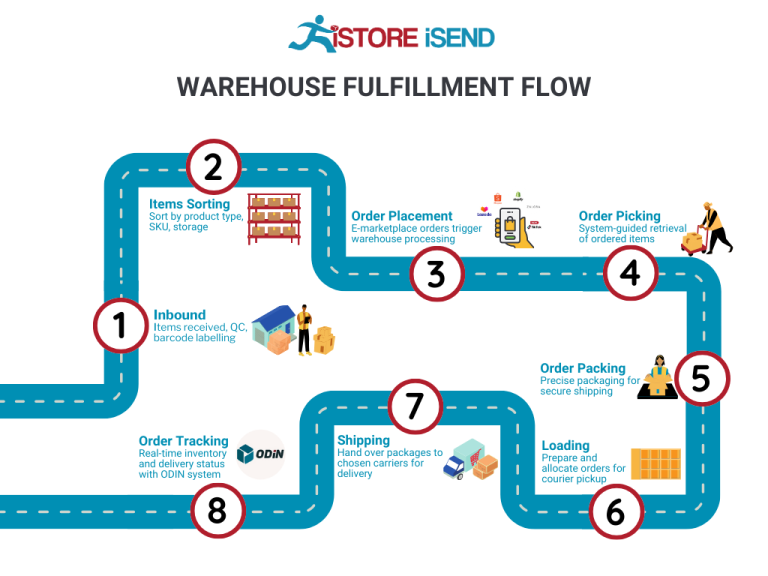
Pros of Fulfillment by Amazon (FBA)
-
Prime Eligibility: One of the most significant advantages of FBA is that products become eligible for Amazon Prime. This means that Prime members can benefit from free two-day shipping, which can significantly increase the visibility and sales potential of your products.
-
Customer Trust: Products fulfilled by Amazon often enjoy increased trust from consumers. Buyers feel more secure purchasing items that are backed by Amazon’s customer service and return policies, which can lead to higher conversion rates.
-
Multi-Channel Fulfillment: FBA isn’t limited to sales on Amazon’s platform. Sellers can also use FBA to fulfill orders from their own websites or other marketplaces, allowing for a centralized logistics solution.
-
Scalability: FBA allows businesses to scale without the need to invest heavily in warehousing or logistics infrastructure. This can be particularly beneficial for small to medium-sized businesses looking to grow quickly.
-
Time Savings: By outsourcing fulfillment to Amazon, sellers can save time on packing and shipping, allowing them to focus on product development, marketing, and other core business functions.
Cons of Fulfillment by Amazon (FBA)
-
High Fees: While FBA can simplify logistics, it comes with costs that can eat into margins. Sellers incur storage fees, fulfillment fees, and potentially additional costs for long-term storage if products don’t sell quickly.
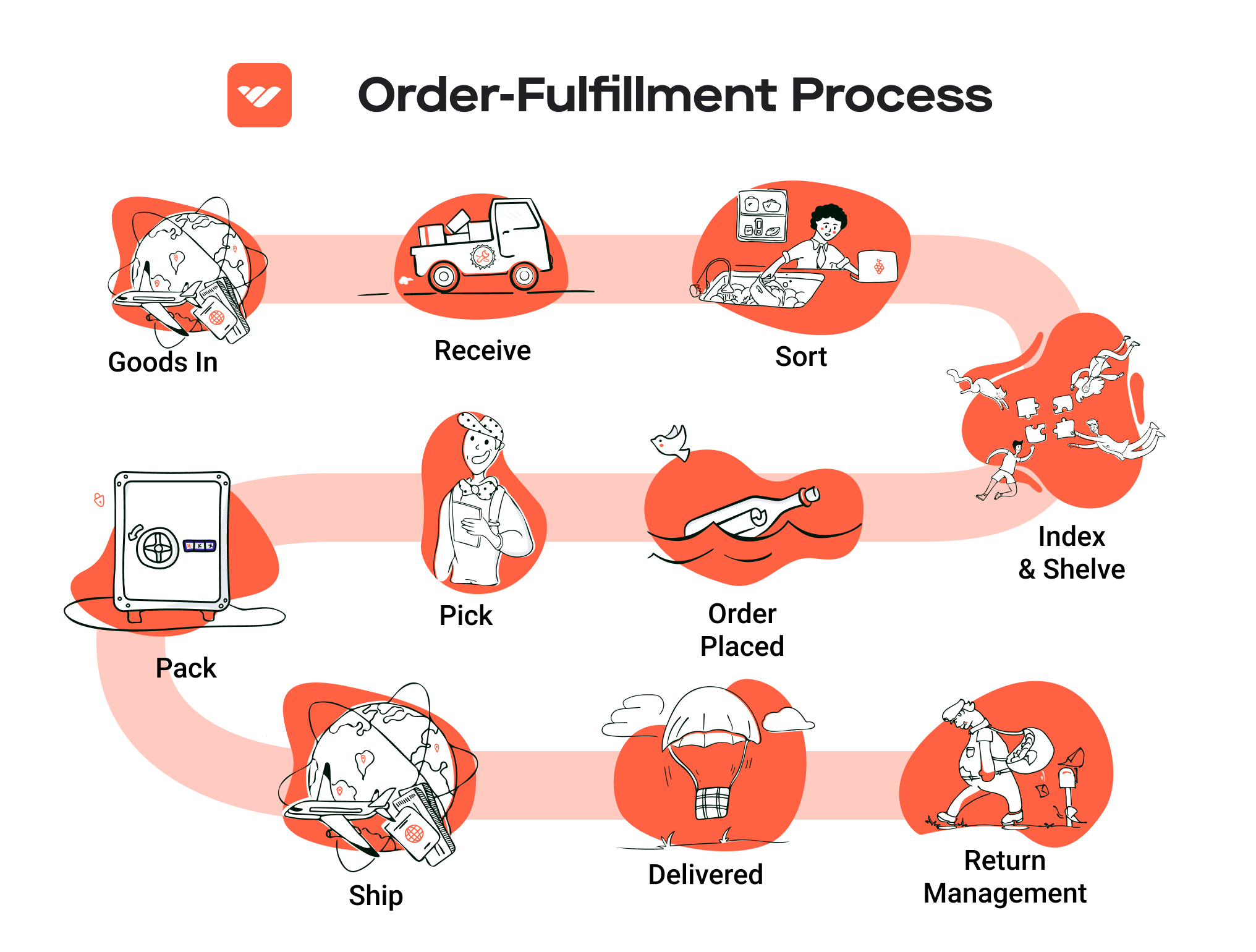
-
Strict Inventory Rules: Amazon has stringent requirements regarding inventory management. Sellers must keep track of their stock levels and ensure that they adhere to Amazon’s guidelines regarding labeling, packaging, and shipping.
-
Commingling Risks: FBA uses a commingling system, which means that products from different sellers can be stored together. This poses a risk if a customer receives a damaged or defective item from another seller, as it may reflect poorly on your business.
-
Less Control Over Customer Experience: While Amazon handles customer service, sellers have less control over the customer experience. Issues related to fulfillment, such as shipping delays or packaging quality, can impact seller ratings and reviews.
-
Dependency on Amazon: Relying heavily on FBA can create a dependency on Amazon’s ecosystem. Changes in Amazon’s policies or fee structures can significantly affect sellers’ operations and profitability.
Who is FBA Best For?
Fulfillment by Amazon is best suited for:
-
Small to Medium-Sized Businesses: Companies that want to scale their operations without investing heavily in logistics and fulfillment infrastructure can benefit significantly from FBA.
-
E-commerce Entrepreneurs: New sellers looking to establish a presence on Amazon can leverage FBA to quickly gain visibility and customer trust.
-
Sellers with High Inventory Turnover: Businesses that have products with a fast sales velocity can maximize their profits through FBA, as high inventory turnover can help offset the associated fees.
-
Brands with Established Demand: Companies that already have a strong brand presence or customer demand can take advantage of FBA to streamline their fulfillment processes and focus on growth.
-
Multi-Channel Sellers: Businesses that sell across various platforms can use FBA to fulfill orders from their own websites or other marketplaces, creating a cohesive fulfillment strategy.
In conclusion, Fulfillment by Amazon offers a robust solution for e-commerce businesses seeking to streamline their logistics and scale operations. However, it’s essential to weigh the benefits against the potential drawbacks, such as fees and loss of control over customer experience. By carefully considering your business model and goals, you can determine if FBA is the right fit for your operations.
Core Services Offered by Fulfillment Centers
Inventory Management & Warehousing
Inventory management and warehousing are foundational services provided by fulfillment centers that streamline the storage and organization of products. Fulfillment centers utilize sophisticated inventory management systems to track stock levels in real-time, allowing businesses to maintain optimal inventory levels without the risk of overstocking or stockouts.
What It Is: This service encompasses the receiving, storing, and tracking of inventory. Fulfillment centers employ advanced technologies such as barcode scanning and RFID (Radio Frequency Identification) to manage inventory efficiently. This ensures that businesses have accurate data regarding their stock availability, which is crucial for timely order fulfillment.
Benefits to E-commerce Businesses:
1. Cost Efficiency: By outsourcing inventory management, e-commerce businesses can reduce overhead costs associated with maintaining a large warehouse, hiring staff, and managing inventory manually.
2. Scalability: Fulfillment centers offer scalable storage solutions, allowing businesses to adjust their inventory levels according to seasonal demand or market fluctuations without the need for significant investment in physical space.
3. Enhanced Accuracy: Automated inventory management reduces human error, ensuring that businesses have the right products available at the right time, thus improving customer satisfaction and loyalty.
Pick and Pack Services
Pick and pack services are critical components of the order fulfillment process, where fulfillment centers efficiently retrieve products from their warehouses and prepare them for shipment based on customer orders.
What It Is: In this process, items are selected (picked) from the shelves according to the specifications of a customer’s order and then packed securely for shipping. This can involve various packing materials and methods to ensure that products arrive safely at their destination.
Benefits to E-commerce Businesses:
1. Speedy Order Fulfillment: Fulfillment centers are equipped with optimized workflows and skilled personnel or automation technologies that significantly reduce the time it takes to pick and pack orders. This leads to quicker shipping times, enhancing customer satisfaction.
2. Error Reduction: With systematic picking processes and automated packing solutions, the likelihood of shipping the wrong items diminishes, which is vital for maintaining brand reputation and customer trust.
3. Resource Optimization: By outsourcing pick and pack services, businesses can focus on core activities such as marketing and product development while leaving the logistics to the experts.
Kitting and Assembly
Kitting and assembly services allow businesses to offer customized product bundles or pre-assembled items, enhancing the customer experience and increasing average order value.
What It Is: This service involves combining multiple individual products into a single package or kit, which may include assembling items to create a finished product. For instance, a fulfillment center might assemble a gift basket or combine various components of a tech gadget into one cohesive unit.
Benefits to E-commerce Businesses:
1. Increased Sales Opportunities: Kitting enables businesses to create attractive product bundles that can be marketed at a premium price, driving higher sales and encouraging customers to purchase more items in a single transaction.
2. Simplified Inventory Management: By consolidating various components into kits, businesses can streamline inventory management, reducing the complexity of tracking multiple SKUs and improving overall efficiency.
3. Enhanced Customer Satisfaction: Offering pre-assembled products or curated kits can enhance the shopping experience, making it easier for customers to find what they need while also providing them with unique options that stand out in the marketplace.
Returns Management (Reverse Logistics)
Returns management, also known as reverse logistics, is an essential service that addresses the challenges of handling product returns efficiently and effectively.
What It Is: This service involves the processing of returned items, including inspecting, sorting, and restocking products that customers have sent back. Fulfillment centers often provide return shipping labels and instructions, making the return process seamless for customers.
Benefits to E-commerce Businesses:
1. Improved Customer Retention: A well-managed returns process enhances customer experience and satisfaction, making customers more likely to shop again despite having to return a product.
2. Cost Management: By effectively managing returns, businesses can minimize losses associated with returned goods, ensuring that restocked items are quickly reintroduced to inventory or that defective items are handled appropriately.
3. Data Insights: Returns management provides valuable insights into customer behavior and product performance, allowing businesses to identify trends, improve product offerings, and optimize inventory based on return patterns.
In summary, leveraging the core services offered by fulfillment centers—inventory management and warehousing, pick and pack services, kitting and assembly, and returns management—can significantly enhance the operational efficiency and scalability of e-commerce businesses. By outsourcing these critical logistics functions, businesses can focus on growth and customer satisfaction while ensuring a smooth order fulfillment process.
How to Choose a Fulfillment Partner: A 6-Point Checklist
Location & Warehouse Network
Importance:
The location of your fulfillment partner’s warehouses is crucial for reducing shipping times and costs. A strategically placed warehouse can enhance delivery speed to your primary customer base, which is essential for maintaining customer satisfaction and loyalty.
Questions to Ask:
– Where are your warehouses located, and how does this align with our target customer demographics?
– Do you have multiple fulfillment centers, and how do they affect shipping times and costs?
– Can you provide information on your shipping carriers and their delivery capabilities?
Technology & Integrations
Importance:
In today’s e-commerce landscape, technology is a cornerstone of efficient order fulfillment. A partner with robust technology can provide real-time tracking, inventory management, and easy integration with your existing e-commerce platforms. This ensures a seamless flow of information and reduces errors.
Questions to Ask:
– What fulfillment management software do you use, and how does it integrate with our e-commerce platform?
– Can you provide real-time order tracking for our customers?
– How do you manage inventory updates, and how frequently is this data synchronized with our system?
Specializations (e.g., Cold Storage, Oversized Items)
Importance:
Different businesses have different needs, and not all fulfillment centers are equipped to handle specific requirements like cold storage for perishables or oversized items. Choosing a partner with the necessary specializations can prevent logistical headaches and ensure compliance with industry regulations.
Questions to Ask:
– Do you have specialized facilities for unique products, such as temperature-sensitive goods or bulky items?
– What certifications do your warehouses hold to ensure compliance with safety and quality standards?
– Can you handle packaging requirements specific to our product type?
Scalability & Capacity
Importance:
As your business grows, your fulfillment needs will evolve. A partner that can scale operations in response to increased demand is vital for sustained growth. Understanding their capacity for handling spikes in order volume, especially during peak seasons, will help you avoid fulfillment issues down the line.
Questions to Ask:
– What is your current capacity for order fulfillment, and how do you manage peak seasons?
– How quickly can you ramp up operations if our order volume increases significantly?
– Can you provide examples of how you’ve supported other clients during periods of rapid growth?
Pricing and Contracts
Importance:
Transparent pricing is essential for maintaining profitability. Understanding the cost structure, including hidden fees, is crucial for budgeting and financial planning. Additionally, the terms of the contract can affect your operational flexibility.
Questions to Ask:
– What is your pricing structure, and are there any additional fees we should be aware of (e.g., storage fees, pick-and-pack fees)?
– How do you handle pricing adjustments during contract renewals?
– Can you provide a sample contract to review, including terms regarding termination and service level agreements?
Customer Support & Reviews
Importance:
Reliable customer support is critical for resolving issues quickly and maintaining operational efficiency. Moreover, reviews from other businesses can provide insight into the partner’s reliability, responsiveness, and overall service quality.
Questions to Ask:
– What customer support options do you provide, and what are your response times?
– Can you share testimonials or case studies from businesses similar to ours?
– How do you handle customer complaints and returns, and what processes are in place to ensure resolution?
Conclusion
Choosing the right fulfillment partner is a significant decision that can impact your e-commerce business’s efficiency and customer satisfaction. By evaluating potential partners using this checklist, you can make an informed choice that aligns with your operational needs and growth goals. Remember, the right partner should not only meet your current requirements but also be a strategic ally as you scale your business.
Understanding Fulfillment Pricing: A Breakdown of Common Fees
Initial Setup Fees
Initial setup fees are typically charged by fulfillment centers to cover the costs of onboarding a new client. These fees can vary significantly based on the complexity of the operation and the specific requirements of your business. Common components that contribute to these costs include:
- Account setup: This involves creating your account in the fulfillment center’s system and integrating it with your e-commerce platform.
- Inventory receiving: If you have a large volume of inventory to send to the fulfillment center initially, the costs of receiving and processing this inventory can be significant.
- Customizations: If your fulfillment needs require special processes, packaging, or software integration, additional fees may apply.
To calculate initial setup fees, fulfillment centers often have a tiered pricing structure based on the volume of inventory and the specific services required. It’s essential to clarify what is included in these fees to avoid unexpected costs down the line.
Receiving Fees
Receiving fees are charged for the process of unloading and inspecting incoming inventory. This fee is usually calculated per pallet or per item, depending on the fulfillment center’s policies. Factors that can influence receiving fees include:
- Volume of inventory: Larger shipments may incur lower per-item fees due to economies of scale.
- Complexity of receiving: If your products require special handling, such as fragile items that need extra care, higher fees may apply.
- Quality checks: If the fulfillment center performs thorough inspections or quality control checks, these services can also add to the receiving fees.
To manage receiving costs effectively, it’s crucial to communicate with your fulfillment partner about your inventory needs and any special handling requirements well in advance.
Storage Fees (per pallet/bin)
Storage fees are incurred for holding your inventory at the fulfillment center. These fees can be structured in various ways, typically calculated on a per-pallet or per-bin basis. Key considerations for storage fees include:
- Duration of storage: Many fulfillment centers charge monthly fees based on how long your inventory is stored. The longer the inventory remains in storage, the higher the cumulative fees.
- Space utilized: Storage fees may vary based on the size and configuration of the items being stored. Larger items may take up more space and incur higher fees.
- Seasonal fluctuations: During peak seasons, such as holidays, storage fees may increase due to higher demand for space.
To minimize storage costs, consider implementing a just-in-time inventory strategy or utilizing data analytics to forecast demand accurately.
Pick & Pack Fees (per item/order)
Pick and pack fees are charged for the labor involved in selecting items from storage and preparing them for shipment. These fees are typically calculated per item or per order and can vary based on:
- Order complexity: Orders with multiple items or custom packaging requirements may incur higher pick and pack fees.
- Automation: Fulfillment centers that utilize automated systems for picking and packing may offer lower fees compared to manual processes.
- Volume discounts: Higher order volumes can lead to discounted rates as fulfillment centers aim to optimize their operations.
Understanding the pick and pack fee structure can help you design your product offerings and packaging strategies to minimize costs while maintaining efficiency.
Shipping Fees
Shipping fees are one of the most significant costs associated with order fulfillment and are determined by various factors, including:
- Carrier selection: Different shipping carriers have different rates, and the choice of carrier can significantly impact shipping costs.
- Package dimensions and weight: Shipping fees are often based on the greater of the actual weight or dimensional weight (DIM weight). Therefore, optimizing package size can lead to cost savings.
- Shipping zones: The distance from the fulfillment center to the customer’s address also affects shipping costs, with longer distances typically resulting in higher fees.
It’s important to regularly evaluate your shipping options and negotiate rates with carriers to ensure you are getting the best deal possible.
Tips for Getting an Accurate Quote
To obtain an accurate quote from a fulfillment partner, consider the following best practices:
- Provide detailed information: Clearly outline your product types, order volumes, and any special handling requirements.
- Ask about all fees: Ensure you inquire about initial setup, receiving, storage, pick and pack, and shipping fees to get a comprehensive understanding of potential costs.
- Discuss potential fluctuations: Talk about how seasonal changes or promotional periods may impact fees, and how the fulfillment center handles these scenarios.
- Seek transparency: A reputable fulfillment partner should be willing to provide a detailed breakdown of their pricing model, including any potential hidden fees.
- Compare multiple quotes: Don’t settle for the first quote you receive. Comparing multiple fulfillment centers can help you identify the best fit for your budget and operational needs.
By understanding the various fulfillment pricing models and how they are calculated, you can make informed decisions that align with your business goals and help streamline your operations as you scale.
Frequently Asked Questions (FAQs) about Fulfillment
1. What is order fulfillment?
Order fulfillment is the complete process of receiving, processing, and delivering customer orders. It encompasses various activities including inventory management, order processing, picking, packing, shipping, and handling returns. The goal is to ensure that customers receive their orders accurately and in a timely manner.
2. Why is order fulfillment important for my business?
Order fulfillment is critical because it directly impacts customer satisfaction and retention. Efficient fulfillment processes help ensure timely deliveries, which enhances the overall customer experience. Poor fulfillment can lead to dissatisfied customers, negative reviews, and ultimately loss of sales.
3. What are the main steps in the order fulfillment process?
The order fulfillment process typically includes the following steps:
1. Receiving Inventory: Accepting and inspecting incoming products.
2. Inventory Storage: Organizing and storing products for easy access.
3. Order Processing: Managing customer orders through an order management system.
4. Picking: Selecting the right items from inventory based on the order.
5. Packing: Preparing items for shipment, including necessary documentation.
6. Shipping: Sending orders to customers through chosen carriers.
7. Returns Processing: Handling returned items and restocking as necessary.
4. What is the difference between a warehouse and a fulfillment center?
A warehouse is primarily a storage facility where goods are kept until they are needed. In contrast, a fulfillment center is specifically designed to handle the entire order fulfillment process, from receiving inventory to shipping orders directly to customers. Fulfillment centers often have advanced technology and systems to manage these tasks efficiently.
5. What is a third-party logistics provider (3PL)?
A third-party logistics provider (3PL) is a company that offers outsourced logistics services, which can include warehousing, inventory management, order fulfillment, and shipping. Partnering with a 3PL can help businesses scale their operations without the need for significant investment in infrastructure and staff.
6. How much do fulfillment services cost?
The cost of fulfillment services varies widely based on factors such as order volume, storage space needed, shipping methods, and additional services (like returns processing). Typically, costs can include fees for receiving inventory, storage, picking and packing, and shipping. It’s essential to request quotes from multiple providers to find the best fit for your budget and needs.
7. What are common challenges in order fulfillment?
Common challenges in order fulfillment include inventory management issues (such as stockouts or overstocking), logistics delays, inaccuracies in order processing, and handling returns efficiently. Businesses must continuously monitor and optimize their fulfillment processes to address these challenges.
8. How can technology improve my order fulfillment process?
Technology can streamline various aspects of order fulfillment, such as inventory management systems, order management software, and automation tools for picking and packing. These technologies enhance accuracy, speed up processing times, and improve overall efficiency, ultimately leading to a better customer experience.
9. What role does customer service play in order fulfillment?
Customer service is crucial in the order fulfillment process as it helps address customer inquiries, manage expectations, and resolve issues related to orders. Effective communication can enhance customer satisfaction and loyalty, especially when dealing with order delays or returns.
10. How can I measure the success of my order fulfillment operations?
Success can be measured through key performance indicators (KPIs) such as order accuracy rate, shipping time, return rate, and customer satisfaction scores. Regularly analyzing these metrics will help identify areas for improvement and ensure that your fulfillment operations are meeting customer expectations.
Conclusion: Is Outsourcing Fulfillment the Right Move for Your Business?
Evaluating the Benefits of Outsourcing Fulfillment
Outsourcing fulfillment can be a game-changer for e-commerce businesses looking to scale. By leveraging a fulfillment service, you can save valuable time and resources that can be redirected towards core business activities like marketing and product development. Instead of juggling the complexities of inventory management, order processing, and shipping logistics, you can focus on growing your brand and enhancing customer experience.
Moreover, partnering with a fulfillment provider offers significant scalability. As your sales grow, fulfillment services can easily adapt to increased order volumes without the need for substantial investment in infrastructure or workforce. This flexibility allows you to meet customer demand seamlessly, ensuring you never miss a sales opportunity due to fulfillment bottlenecks.
Expertise is another critical advantage of outsourcing. Fulfillment centers specialize in logistics, often utilizing advanced technologies and proven processes to streamline operations. This expertise can lead to improved accuracy, reduced shipping times, and enhanced customer satisfaction—all vital for maintaining your competitive edge in today’s fast-paced e-commerce landscape.
However, the success of outsourcing hinges on choosing the right fulfillment partner. A thorough evaluation of potential providers is essential. Look for partners who align with your business goals, offer transparent pricing, and have a track record of reliability and customer service.
Call to Action
To determine if outsourcing fulfillment is the right next step for your business, conduct a comprehensive audit of your current shipping processes. Assess your fulfillment costs, customer satisfaction levels, and operational efficiency. This analysis will help you understand where improvements can be made and whether a fulfillment partner can facilitate your growth. Embrace the opportunity to enhance your operations and focus on what truly matters: growing your business.
Important Disclaimer
⚠️ Important Disclaimer
The information in this guide is for educational purposes. Fulfillment services, pricing, and platform features change frequently. Always conduct your own due diligence and consult with providers directly before making business decisions.

